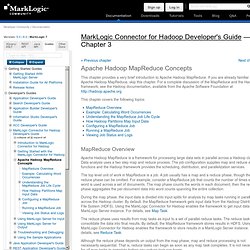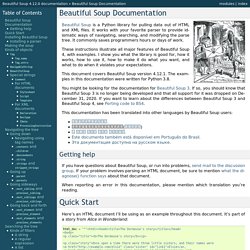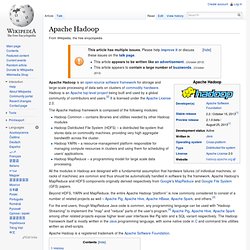

Apache Hadoop MapReduce Concepts (MarkLogic Connector for Hadoop Developer's Guide) — MarkLogic 7 Product Documentation. This chapter provides a very brief introduction to Apache Hadoop MapReduce.

If you are already familiar with Apache Hadoop MapReduce, skip this chapter. For a complete discussion of the MapReduce and the Hadoop framework, see the Hadoop documentation, available from the Apache Software Foundation at This chapter covers the following topics: MapReduce Overview Apache Hadoop MapReduce is a framework for processing large data sets in parallel across a Hadoop cluster. The top level unit of work in MapReduce is a job. During the map phase, the input data is divided into input splits for analysis by map tasks running in parallel across the Hadoop cluster. The reduce phase uses results from map tasks as input to a set of parallel reduce tasks. Although the reduce phase depends on output from the map phase, map and reduce processing is not necessarily sequential.
MapReduce operates on key-value pairs. The keys in the map output pairs need not be unique. Example: Calculating Word Occurrences <? Create Online Database, Build Web Database, Web based: Zoho Creator. Beautiful Soup Documentation — Beautiful Soup 4.2.0 documentation. Beautiful Soup is a Python library for pulling data out of HTML and XML files.

It works with your favorite parser to provide idiomatic ways of navigating, searching, and modifying the parse tree. It commonly saves programmers hours or days of work. These instructions illustrate all major features of Beautiful Soup 4, with examples. I show you what the library is good for, how it works, how to use it, how to make it do what you want, and what to do when it violates your expectations. The examples in this documentation should work the same way in Python 2.7 and Python 3.2. You might be looking for the documentation for Beautiful Soup 3. This documentation has been translated into other languages by Beautiful Soup users: 这篇文档当然还有中文版.このページは日本語で利用できます(外部リンク)이 문서는 한국어 번역도 가능합니다. Here’s an HTML document I’ll be using as an example throughout this document. Here are some simple ways to navigate that data structure: One common task is extracting all the URLs found within a page’s <a> tags: Tag Name.
How To Build A Basic Web Crawler To Pull Information From A Website (Part 1) The Google web crawler will enter your domain and scan every page of your website, extracting page titles, descriptions, keywords, and links – then report back to Google HQ and add the information to their huge database.

Today, I’d like to teach you how to make your own basic crawler – not one that scans the whole Internet, though, but one that is able to extract all the links from a given webpage. Generally, you should make sure you have permission before scraping random websites, as most people consider it to be a very grey legal area. Still, as I say, the web wouldn’t function without these kind of crawlers, so it’s important you understand how they work and how easy they are to make. To make a simple crawler, we’ll be using the most common programming language of the internet – PHP. Don’t worry if you’ve never programmed in PHP – I’ll be taking you through each step and explaining what each part does. Before we start, you will need a server to run PHP. <? Set the target URL as. Apache Hadoop. Apache Hadoop is an open-source software framework for storage and large-scale processing of data-sets on clusters of commodity hardware.

Hadoop is an Apache top-level project being built and used by a global community of contributors and users.[2] It is licensed under the Apache License 2.0. The Apache Hadoop framework is composed of the following modules: Hadoop Common – contains libraries and utilities needed by other Hadoop modulesHadoop Distributed File System (HDFS) – a distributed file-system that stores data on commodity machines, providing very high aggregate bandwidth across the cluster.Hadoop YARN – a resource-management platform responsible for managing compute resources in clusters and using them for scheduling of users' applications.Hadoop MapReduce – a programming model for large scale data processing.
Apache Hadoop is a registered trademark of the Apache Software Foundation. History[edit] Hadoop was created by Doug Cutting and Mike Cafarella[5] in 2005. Architecture[edit]